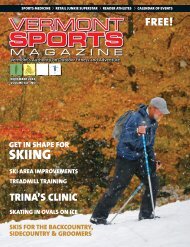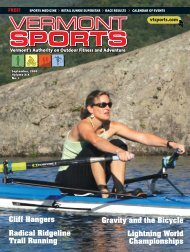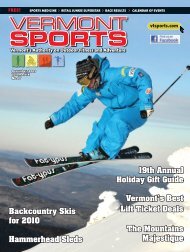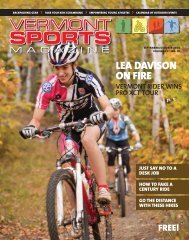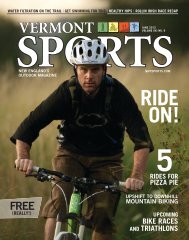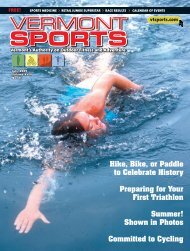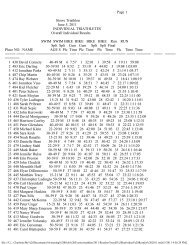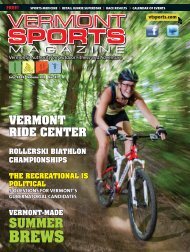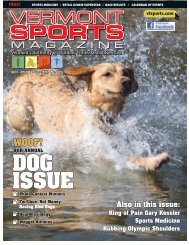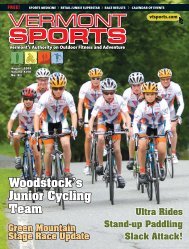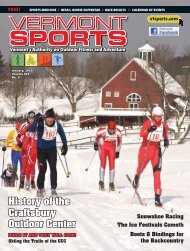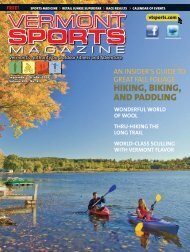Create successful ePaper yourself
Turn your PDF publications into a flip-book with our unique Google optimized e-Paper software.
CLASSIC<br />
VS.<br />
SKATE SKIING<br />
BY PHYL NEWBECK<br />
PHOTOS BY KATE CARTER<br />
B<br />
ack in the old days, going cross-country skiing<br />
didn’t involve much decision making. You<br />
strapped your leather boots onto your wooden<br />
skis and sallied forth. Now, not only is there a vast<br />
assortment of gear, but there are different disciplines to<br />
choose from, and the choice of classic versus skate skiing<br />
informs much of the equipment decision-making. While<br />
most skiers are loathe to say they prefer one over the<br />
other (“I like apples and I like oranges,” was the way<br />
Catamount Trail Association executive director Jim<br />
Fredericks phrased it), there are distinct advantages<br />
and disadvantages to each discipline.<br />
PRICE<br />
According to Jake Hollenbach, sales associate at the Ski<br />
Rack in Burlington, classic skiing gear is less expensive<br />
than skating. However, Hollenbach divides classic (which<br />
he believes is more accurately called “stride skiing”) into<br />
three categories: racing or true classic skiing, touring,<br />
and backcountry. Of the three, touring skis are the least<br />
expensive, running a novice roughly $240 for skis, boots,<br />
bindings, and poles. In contrast, backcountry and racing<br />
set-ups cost closer to $400. Hollenbach says there is no<br />
equivalent “touring” level for skate skiing, the set-up<br />
for which costs roughly $450 thanks to the boots which<br />
have greater ankle support.<br />
POPULARITY<br />
Hollenbach says skate skiing has become more popular<br />
in the United States because it is considered crosstraining<br />
for running, cycling, and other warm-weather<br />
sports. However, in other parts of the world, such as<br />
Scandinavia, classic skiing, which is the more traditional<br />
discipline, is still more popular.<br />
Eli Enman of Sleepy Hollow Ski and Bike Center says<br />
most recreational skiers stick to classic skiing, especially<br />
those who are new at the sport. However, Enman has<br />
found that more serious athletes, in particular those<br />
who are competitive in summer sports such as mountain<br />
or road biking, prefer skate skiing. Enman notes there is<br />
also a generation gap. Since skate skiing only began in<br />
the early 1980s, many of those who learned to ski before<br />
that time have not taken up the new discipline.<br />
LEARNING CURVE<br />
There doesn’t seem to be a consensus on which form of<br />
skiing is easiest to learn. “After four to fi ve days on snow,”<br />
says Hollenbach, “most folks are profi cient enough to<br />
get proper forward propulsion and enjoy skate skiing.<br />
Classic takes longer, balance-wise.”<br />
Fredericks believes that for recreational skiers,<br />
classic skiing is easier to learn, but for serious racers,<br />
skating is the discipline that can be mastered faster.<br />
He thinks skiers can achieve greater profi ciency with<br />
less skill when skate skiing, particularly those with a<br />
background in ice skating. “You can learn how to skate<br />
with a lesson and do pretty well,” he says. Fredericks,<br />
who was once the director of the Rossignol Nordic race<br />
team, believes it is harder to learn proper classic skiing<br />
technique because it requires more precision.<br />
Eric Tremble, coach for the Ethan Allen Biathlon<br />
Club, believes the learning curve for skate skiing<br />
is steeper. Likewise, Enman, who moonlights as an<br />
assistant Nordic coach at Champlain Valley Union High<br />
School, says, “Classic is a lot more intuitive; it’s easier<br />
to learn right off.” Andy Grab, who coaches kids at the<br />
Mansfi eld Nordic Club, which is part of the Bill Koch<br />
League, says kids are initially introduced to classic<br />
skiing on waxless skis, at least in part because it is<br />
easier to learn. Additionally, since classic skiing does<br />
not require groomed trails, the kids can practice in their<br />
own backyards. Once they have achieved some measure<br />
of success, Grab will introduce them to skate skiing<br />
through a more formal teaching process.<br />
FUN FACTOR<br />
Fredericks leans toward skate skiing on fast surfaces,<br />
but prefers classic on cold days when he can generate<br />
more body heat without the wind chill of high speed<br />
racing. Given the undulating terrain of many <strong>Vermont</strong><br />
Nordic centers, he considers skate skis more versatile<br />
because they don’t require a change of wax as the<br />
elevation changes. The lack of waxing complications was<br />
also cited by Enman as a plus for skate skiing. Tremble<br />
said that for a recreational workout, he fi nds classic skis<br />
to be more enjoyable.<br />
SPEED<br />
Any question of which discipline is fastest was answered<br />
when Tremble won the Catamount Trail Association<br />
Backcountry Challenge in 2009, in part by skating the<br />
fi rst part of the course on a pair of backcountry skis<br />
without metal edges. Skate skiing, he notes, will always<br />
be faster, which is why it is the sole form of skiing used in<br />
biathlon. Enman adds that when the temperature is ten<br />
below zero or lower, classic might be faster, but otherwise<br />
skating will always be the speedier discipline.<br />
BENEFITS<br />
Enman considers skating to be a better workout, in part<br />
because a skater uses his/her legs while skating downhill,<br />
whereas classic skiers can only double pole because they<br />
are going too fast to kick. Additionally, skate skiing, with<br />
its longer poles, provides a longer arm push, whereas the<br />
classic push-off is quick and snappy.<br />
Fredericks notes that neither discipline puts much<br />
stress on the body if done correctly, but even when done<br />
incorrectly, it’s hard to do much damage classic skiing.<br />
However, because of the amount of lateral turning<br />
involved, skiers can strain their knees by skate skiing<br />
incorrectly. Fredericks says both provide an equal benefi t<br />
to athletes if done properly, using abdominal, lateral,<br />
and back muscles, in addition to arms and legs.<br />
CONDITIONS<br />
Fredericks says classic skiing is easier on really cold days<br />
(below 10 degrees), while skating is preferable when the<br />
temperature is above freezing, making waxing classic<br />
skis more challenging. Likewise, skating is virtually<br />
impossible with more than a few inches of snow, but<br />
an absolute joy in the springtime. Enman agrees that<br />
classic skiing works better on very cold days, adding that<br />
when the temperature is on or above freezing, there is a<br />
greater movement towards skate skiing from those who<br />
don’t want to deal with klister wax.<br />
So there you have it: Apples and oranges both taste<br />
good. Get your skis—any skis—and get out and enjoy<br />
the snow.<br />
Phyl Newbeck lives in Jericho with her partner, Bryan,<br />
and two cats. She admits to a having a hard time<br />
mastering skate skiing, despite her background as a<br />
fi gure skater. Phyl is also a cyclist, kayaker, and lover of<br />
virtually any sport which does not involve motors. She is<br />
the author of Virginia Hasn’t Always Been for Lovers:<br />
Interracial Marriage Bans and the Case of Richard and<br />
Mildred Loving.<br />
February 2010 <strong>Vermont</strong> <strong>Sports</strong> 11



